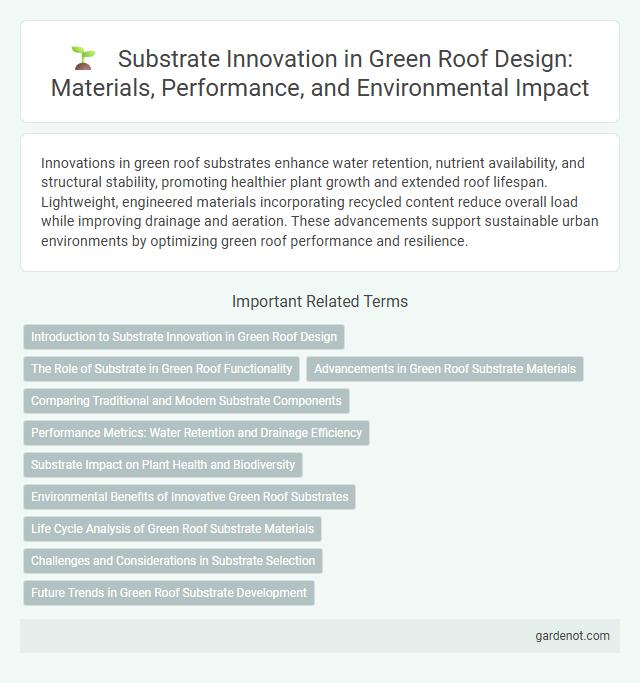Innovations in green roof substrates enhance water retention, nutrient availability, and structural stability, promoting healthier plant growth and extended roof lifespan. Lightweight, engineered materials incorporating recycled content reduce overall load while improving drainage and aeration. These advancements support sustainable urban environments by optimizing green roof performance and resilience.
Introduction to Substrate Innovation in Green Roof Design
Substrate innovation in green roof design centers on developing lightweight, nutrient-rich growing mediums that enhance plant health and water retention while reducing structural load. Advanced substrates incorporate materials like expanded shale, biochar, and recycled aggregates to improve porosity, drainage, and sustainability. These innovations enable more resilient green roofs capable of supporting diverse vegetation in urban environments.
The Role of Substrate in Green Roof Functionality
The substrate in green roofs plays a critical role in water retention, root support, and nutrient supply, directly impacting plant health and overall system performance. Innovations in substrate materials, such as lightweight aggregates and biochar incorporation, enhance water filtration and reduce structural load while improving microbial activity. Optimized substrate design increases stormwater management efficiency and extends green roof longevity by promoting robust vegetation growth and substrate stability.
Advancements in Green Roof Substrate Materials
Advancements in green roof substrate materials have led to the development of lightweight, nutrient-rich blends that enhance plant growth while improving water retention and drainage. Innovations include biochar-infused substrates that boost soil fertility and microbial activity, as well as recycled and sustainable components reducing environmental impact. These optimized substrates support longer-lasting, resilient green roofs capable of better stormwater management and thermal regulation.
Comparing Traditional and Modern Substrate Components
Modern green roof substrates incorporate lightweight materials such as expanded shale, recycled aggregates, and biochar, enhancing drainage and nutrient retention compared to traditional substrates composed mainly of heavy mineral soils and organic compost. Innovations in substrate design improve plant growth resilience, reduce overall roof load, and optimize water retention capacity, contributing to greater sustainability and energy efficiency. Research shows that tailored substrates with engineered porosity and balanced pH levels significantly outperform conventional mixes in supporting diverse vegetation and microbial activity.
Performance Metrics: Water Retention and Drainage Efficiency
Innovative green roof substrates are engineered to optimize water retention and drainage efficiency, balancing moisture availability for plant growth with rapid excess water removal to prevent root saturation. Advanced materials such as lightweight porous aggregates and biochar enhance substrate porosity and water-holding capacity, directly improving hydrological performance metrics. These improvements contribute to extended drought resilience and effective stormwater management, critical parameters for sustainable urban green roofing systems.
Substrate Impact on Plant Health and Biodiversity
Innovations in green roof substrates significantly enhance plant health by improving water retention, nutrient availability, and root aeration, which collectively support diverse vegetation. Optimized substrates promote greater biodiversity, enabling a wider range of plant species to thrive and sustain urban ecosystems more effectively. Enhanced substrate compositions reduce soil compaction and heavy metal accumulation, fostering resilient microbial communities critical for long-term ecological balance.
Environmental Benefits of Innovative Green Roof Substrates
Innovative green roof substrates enhance stormwater management by increasing water retention and reducing runoff, promoting urban flood mitigation. These advanced materials improve thermal insulation, lowering building energy consumption and reducing carbon footprints. Enhanced microbial activity in novel substrates supports pollutant degradation, contributing to improved air quality and overall urban ecosystem health.
Life Cycle Analysis of Green Roof Substrate Materials
Advanced substrate innovations for green roofs emphasize sustainable materials that enhance plant growth while minimizing environmental impact. Life Cycle Analysis (LCA) of green roof substrate materials evaluates carbon footprint, resource depletion, and end-of-life recyclability to optimize ecological benefits. Incorporating recycled aggregates and lightweight, nutrient-rich components improves substrate performance and supports urban sustainability goals.
Challenges and Considerations in Substrate Selection
Substrate innovation in green roofs addresses critical challenges such as weight limitations, water retention, and nutrient availability to ensure plant health and structural integrity. Selecting an optimal substrate involves balancing lightweight materials with sufficient porosity and moisture-holding capacity to prevent root desiccation and promote sustainable vegetation growth. Considerations include compatibility with local climate, drainage efficiency, and long-term durability to optimize green roof performance and reduce maintenance costs.
Future Trends in Green Roof Substrate Development
Future trends in green roof substrate development emphasize lightweight, nutrient-rich materials with enhanced water retention and pollutant filtration capabilities. Innovations include biochar integration, mycorrhizal fungi inoculation, and recycled industrial by-products to improve sustainability and plant growth. Research focuses on optimizing substrate porosity and microbial activity to support urban biodiversity and climate resilience.
Substrate innovation Infographic

 gardenot.com
gardenot.com